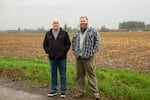Farmer Gary Cook used to feel such pride in NORPAC.
He’d been growing for the farmer-owned cooperative since 1982. Served for years on its board. He loved walking into the store, buying bags of his own frozen corn or green beans. Telling other people to buy them too.
“We had pride in the quality of the products, the labels, our reputation,” he said. “You loved driving down the freeway and seeing the signs. And so, to see it all fall apart, it’s heartbreaking.”
Today, NORPAC is gone.
Until recently, it was the largest fruit and vegetable processor in Oregon. But in August, the nearly century-old cooperative declared bankruptcy and sold itself off in pieces.
Sold: its facility in Quincy, Washington.
Sold: its inventory, trademarks and even the NORPAC name.
The $49 million sale of the last big piece — three processing and packing plants in Salem, Brooks and Stayton — was finalized Friday. The announcement of a further sale of the Brooks plant was expected momentarily.
“It has been one of the greatest disappointments of my life,” Cook said.

The mostly empty NORPAC plant in Stayton, Ore., on Jan. 22, 2020. The nearly century-old farmers' cooperative declared bankruptcy last year.
Kate Davidson / OPB
The impact of NORPAC’s bankruptcy is incalculable.
NORPAC was like the factory in a factory town, where you could get a job straight out of high school. Since 1924, teenagers in the Salem area spent summers picking crops for the cooperative’s farmers. Later, they could work at what was then the cannery. They joined siblings, parents and other relatives on the plant floor. Some met husbands and wives there.
When Pam John first started at the Stayton plant, she worked for her mother-in-law in payroll. Thirty-six years went by.
On Dec. 20, 2019, her job was terminated.
“It’ll go past, this too shall pass,” she said, her voice in shards. “The glass is half full.”
For almost 100 years, the farmers' cooperative shaped work, lives and the land in the Willamette Valley. Now it's gone. Here's who's left.
Click a title to jump to a section or just read straight through.
THE WORKERS | THE FARMERS | THE RESEARCHERS
THE WORKERS
The WARN notices started in September.
The first announced the permanent closure of NORPAC’s Stayton plant. Then Brooks and Salem. More than 1,400 NORPAC jobs were ending, the company warned, both year-round and seasonal.
By then, Pam John had spent decades in the print shop at the Stayton plant and she got to work. She printed off hundreds of copies of a notice alerting her colleagues their jobs would end.
“I just couldn’t believe it was real,” she said. “It was surreal. I knew the end was coming, but I didn’t want to believe it.”

Pam John in her son's home in Aumsville, Ore., on Jan. 27, 2020. She worked at NORPAC's Stayton facility for 36 years.
Kate Davidson / OPB
Evan Mackie’s last day at Stayton was also Dec. 20. The longtime maintenance manager stayed until the ammonia was pumped out of the refrigeration system. Then his 29-year career at NORPAC ended.
“It’s heartbreaking,” he said. “I mean, what can you do? You want to remain employed.”
Mackie scrambled to refill prescriptions before his health insurance disappeared.
“I’m a type one diabetic, so I have a lot of prescriptions and accoutrements that need to go along with my insulin pump,” he said. He stocked enough for three months. “But as far as doctor visits and everything else, that’s gonna be a challenge here in the near future.”
Mackie hoped to find a new job before seeking health insurance from the state’s Medicaid program. Both he and Pam John are collecting unemployment benefits.
If there's any silver lining for workers in the NORPAC bankruptcy, it's that it happened during a period of record low unemployment in Oregon. It's far easier to find work now than it would have been during the depths of the Great Recession.

Few cars remain parked outside NORPAC's plant in Stayton, Ore., on Jan. 22, 2020. The jobs of hundreds of workers, both year-round and seasonal, were terminated during bankruptcy.
Kate Davidson / OPB
Hundreds of NORPAC workers attended job fairs organized within the plants themselves. They attended rapid response sessions in multiple languages, including Spanish, Vietnamese and Marshallese. Local workforce development officials expressed hope that many workers would find new jobs. But they also asked the Oregon Employment Department for an economic impact analysis.
State economists published that analysis in January, focusing on the ripple effects of the NORPAC plant closure in Stayton. Starting with the direct loss of 485 jobs, their analysis projected a cost of nearly $307,000,000 a year in lost wages, decreased purchases from suppliers and lower household spending. It estimated an additional 800 jobs in Marion County were at risk of being lost.
The modeling did not predict what would happen if workers found new jobs.
In fact, more than 200 former NORPAC workers were re-hired at the Salem plant, at least temporarily. Midway through the bankruptcy process, a company owned by the agribusiness entrepreneur Frank Tiegs began leasing the facility from NORPAC. Tiegs had also bought NORPAC's Quincy facility through a subsidiary of his Oregon Potato Company. It was Tiegs that bought the cooperative's bulk inventory, trademarks and trade names. And even though the global cold storage company Lineage Logistics purchased NORPAC's Willamette Valley plants on Friday, Tiegs planned to then buy the Brooks plant and consolidate operations there.
The announcement of that sale may come at any moment.
Tiegs previously told the Capital Press he planned to buy and gut the aged Stayton plant as well. He stood poised to shape the future of fruit and vegetable processing in the Willamette Valley.

Evan Mackie sits in his living room on Jan. 27, 2020, in Aumsville, Ore. The former NORPAC worker described his job search as slow.
Kate Davidson / OPB
Meanwhile, former Stayton maintenance manager Evan Mackie had one word for his own job search: slow. His girlfriend, another former NORPAC worker, did find a new job.
“She calls me her house bitch,” he chuckled. “I clean, I cook and I take care of the dogs, and yeah … I sleep late and I drink beer a lot. But hopefully that’s gonna change soon.”
Pam John wasn’t as optimistic. She was 60 years old, with only a high school diploma. She’d spent decades at a plant where her mother, mother-in-law, sister, brother, husband and children had all worked at some point. She had prided herself on her work ethic. Now she felt scared and devalued.
“You don’t feel like you were important at all,” she said. “Kind of like one of the supervisors said a long time ago — we’re all just numbers and we can all be replaced. Or gotten rid of. That’s how you feel.”
THE FARMERS

Fourth-generation farmer Matthew Cook drives through his family's farm in Albany, Ore., on Jan. 22, 2020. NORPAC's bankruptcy left him with a host of questions about how to plan for the future.
Kate Davidson / OPB
Driving through his family’s farm in Albany, Matthew Cook pointed to a relic of the recent past.
“To our right is a corn field we grew for NORPAC,” he said. “It’s about 60 acres. It’s just stubble right now. Stalks left in a field.”
Those stalks in the field were part of a family legacy: generations of Cook farmers who grew for NORPAC. Father Gary Cook became a member-grower in 1982, once cultivating hundreds of acres for the cooperative he owned with dozens of other farmers. He served for years on its board, including as board chair.
“You share in the good times and the bad times,” he said.
That all came crashing to a halt when NORPAC declared bankruptcy in August.
“It’s heartbreaking,” said 38-year-old Matthew Cook, the farm’s fourth generation. “It hurts.”
The pain is partly financial, deeply emotional, and it comes in layers.
The first layer: near-term cash. Gary Cook said NORPAC still owed Cook Family Farms more than $200,000 for its 2019 crop. He said bigger growers had it worse. The Cooks’ farm was diversified, growing more than the base acres of green beans and sweet corn the cooperative promised to buy every year. Still, Matthew Cook worried how lenders would view their loss.
“The fear of banks not loaning money to us is very real,” he said.
The second layer: uncertainty. The biggest fruit and vegetable processor in the region had just vanished. Planting season approached.
“Where’s the market gonna go with vegetables?” he asked. “What am I going to be able to fill the land with next year? How am I going to feed my family next year? It’s all unknown. I mean, this is my life.”
The third layer: ownership.
NORPAC ownership wasn’t quite like owning stock in a company.

The rainy view from Cook Family Farms in Albany, Ore., on Jan. 22, 2020. Three generations of Cook farmers were member-growers for NORPAC.
Kate Davidson / OPB
In better years, the cooperative would “retain” a portion of member-growers’ earnings. That money capitalized the company and was supposed to be returned to growers within a certain period of time.
Increasingly, it wasn’t.
According to claims filings, Cook Family Farms had more than $1 million invested in NORPAC when it went bankrupt.
The Cooks weren’t expecting to see that money again. And they weren’t alone.
NORPAC’s approximately 140 member-growers were “equity-like” in their nature, according to Al Kennedy of Tonkon Torp, the lead attorney representing NORPAC in its Chapter 11 bankruptcy case.
That means they’re low on a long list of creditors waiting to be repaid. For example, the $125 million secured claim of CoBank takes precedence. As do the claims of various lien holders, as well as non-member cash growers protected by state and federal law.
“There is a substantial likelihood they will not be paid anything more, although that is not certain at this point,” Kennedy said earlier in January.

Gary and Matthew Cook stand by the stubble of a corn field on their family farm in Albany, Ore., Jan. 22, 2020. They both described NORPAC's bankruptcy as heartbreaking.
Kate Davidson / OPB
The disappointment weighs on Gary Cook, who used to take such pride in walking into the store and seeing the FLAV-R-PAC brand. He spent years on NORPAC’s board, including during its decline.
“It’s amazing how many nights of sleep I’ve lost,” he said. “In the last year and a half, waking up in the middle of the night and saying: How?”
It’s a tough way to wind down a farming career.
“There are families that have continually grown for this cooperative since 1924,” he said. “It’s a big deal for that to go away.”
THE RESEARCHERS
You may never have heard of OR 5630. But you’ve probably eaten it.
It’s the main type of green bean grown in the Willamette Valley, a bush Blue Lake variety. It was developed in the decadeslong breeding program at Oregon State University.
“I’m the third in a line of breeders who’ve been breeding green beans at Oregon State for the processed vegetable industry,” said Jim Myers, a professor in the horticulture department.
His research was supported, until recently, by NORPAC.
NORPAC, along with other processors in the state, collected small assessments from farmers delivering their beans, beets, broccoli, carrots, cauliflower and sweet corn for processing. The Oregon Processed Vegetable Commission, including farmer Matthew Cook, distributed that money for agricultural research. NORPAC supplied the lion’s share of funding, though its contributions fell in recent years.
From $141,000 in 2013 to zero last year, according to commission data.

Professor Jim Myers has long worked with Oregon State University's green bean breeding program. He often used NORPAC funding in his research.
Lynn Ketchum, Oregon State University
Researchers never received enormous sums.
Still, the evaporation of NORPAC funding has a meaningful impact on a scientific community that helps ensure diverse crops can thrive in the Willamette Valley.
Take white mold, the fungus known for devastating soybeans in the Midwest.
With support from NORPAC, Myers has been trying to breed green beans that are resistant to the disease, a serious problem for valley growers. If more than 3% of a farmer’s green beans have moldy pods, he said, processors will reject them.
“It’s a difficult one,” he said, “because unlike a lot of diseases which we’ve developed resistance for, that are controlled by single genes, this is a resistance that’s controlled by many genes with small effect.”
So he’s borrowed genes from dried pinto beans. From an Indian variety. From scarlet runner beans. It’s a yearslong process that benefits from the consistent funding Myers received from NORPAC and other processors.
For OSU’s Ed Peachey, the funding’s greatest value has been rapid response.
In the early 2000s, he used commission money to investigate root rot attacking sweet corn in the valley. He found that reducing irrigation during the crop’s first six to eight weeks greatly diminished the impact of root rot later in the season.
“We can respond very rapidly to critical concerns,” he said. “When a problem comes up, the funding’s available. Many of the other granting agencies that we work with, it’s quite an elaborate process getting a grant in and getting a response back.”
Oregon’s remaining processors continue to collect assessments for research. That includes National Frozen Foods, part of the food processing empire owned by Frank Tiegs, the man poised to run NORPAC’s Brooks facility.
How much money the commission gets to support agricultural research in the future could depend on Tiegs’ decisions, including what fruits and vegetables his company processes and how much.
Those are among the questions former NORPAC farmers and workers have been asking, too.
